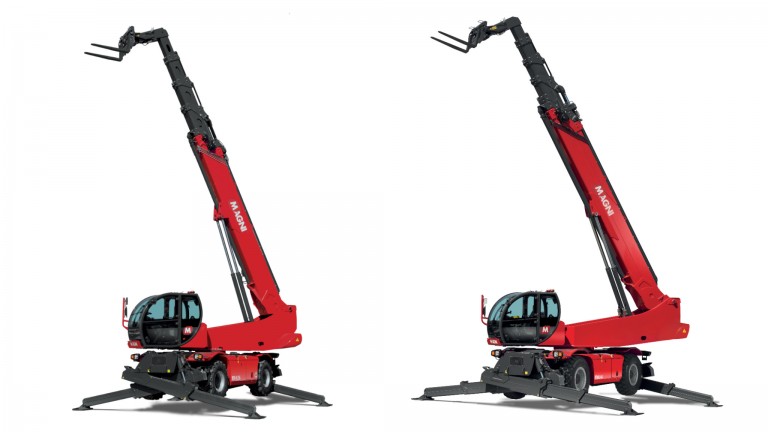Magni has extended its rotating telehandler range with the new RTH 8.35 and 8.46 models.
The 8.35 was built from the redesign of Magni’s 6.36 model, showcasing upgraded load charts and a 2-tonne (4,409-pound) lifting capacity boost. This machine is equipped with two extension modes, M1 and M2. These two modes give access to two different load charts. The standard extension mode, M1, offers the operator maximum reach and higher load capacities at the maximum height while M2 restricts reach to provide an increased load capacity of up to 8 tonnes (17,600 pounds).
Compared to the previous 6.35 model, the 8.35 delivers maximum load capacities 33 percent higher in mode M2 and 20 percent higher in mode M1.
The other model, the RTH 8.46, was created from a restyling of the 6.46 model, as it has a new boom, developed to provide lifting capacities of up to 8 tonnes (17,600 pounds). Inheriting the two extension modes, M1 and M2, already present on the 6.46, the 8.46 is a rotating telehandler with one of the highest lifting heights. Compared to the 6.46, the 8.46 offers increased height, a maximum reach that is increased by one metre (three feet), and a load capacity of up to 8 tonnes at 22 metres (17,600 pounds up to 72 feet),. The machine can carry one tonne (2,200 pounds) to a horizontal reach of 31 metres (101 feet) and can carry 500 kilograms (1,100 pounds) to a maximum reach of 33 metres (108 feet).
The 8.35 and the 8.46 can be used in multiple ways by changing the attachment. Using forks it can operate as a telehandler, by fitting the winch it can be used like an off-road crane, and by attaching the basket the machine can be used like an aerial platform. The RFID system on the machine recognizes the attachment and automatically sets the relevant safety devices and load chart.
The machine’s cab is ROPS/FOPS Level 2 certified. As part of increasing safety, Magni improved visibility from the cab while maintaining regulatory and safety compliances. Moving the cab further forward, increasing the glazing in the top section, and installing a slender steering column, all work to provide the operator with more visibility of the job site.
Magni also implemented an easy-access system that makes getting into and out of the cab easier by permitting a slight misalignment between the turret and chassis.
The cab interiors have also been restyled and all panelling is now injection-moulded. Courtesy lights fitted in various points inside the cab switch on when the door is opened. These LED lights can be dimmed and gradually fade out once the machine is switched off.
The air flows inside the cab have been improved by redesigning the bottom section of the windscreen. A sunblind, which can be locked in two different positions, is fitted in the roof above the operator’s head.
In the new cab both the armrests, which move with the seat, can be raised, creating a storage compartment underneath the right armrest. A special case for the remote control is provided in the rear of the cab, behind the seat, to protect it from dirt, wear, and knocks.
Magni’s new on-board control system
The software installed on the new RTH range, also accessible from the touch screen, has been completely renewed. The restyled interface graphics ensure easy use with user-friendly icons to identify the various functions.
In an upgrade from the previous release, the software now includes a main menu accessible from the various screens, with new functions to provide a smoother user experience.
The main functions include:
- Handling mode: allowing boom and traction speeds to be separated for more precise, faster movements when extending the boom while moving the vehicle.
- Eco mode: this allows the engine rpm to be automatically reduced once the maximum speed is reached during on-road travel at constant speed, reducing fuel consumption and CO2 emissions.
- Dedicated pre-settings: three new presets which can be selected by the operator, from the most precise to the most reactive.
Another innovation on the machines is the Magni LLD (live load diagram) system, which offers three different versions of the load chart screen for a complete view of the operating limits, to enable work in total safety:
- Standard: displaying all the load bands (also featured on previous versions).
- Dynamic: displaying the working area available in relation to the load being lifted.
- 360-degree dynamic: which displays the working area available from above, enabling greater precision when working in conditions of varying stability.
Last but not least, like the whole of the new RTH range, these two models are equipped with a reversing camera, visible in the MCTS monitor, that is activated automatically when reverse gear is engaged.
Read the full article here











